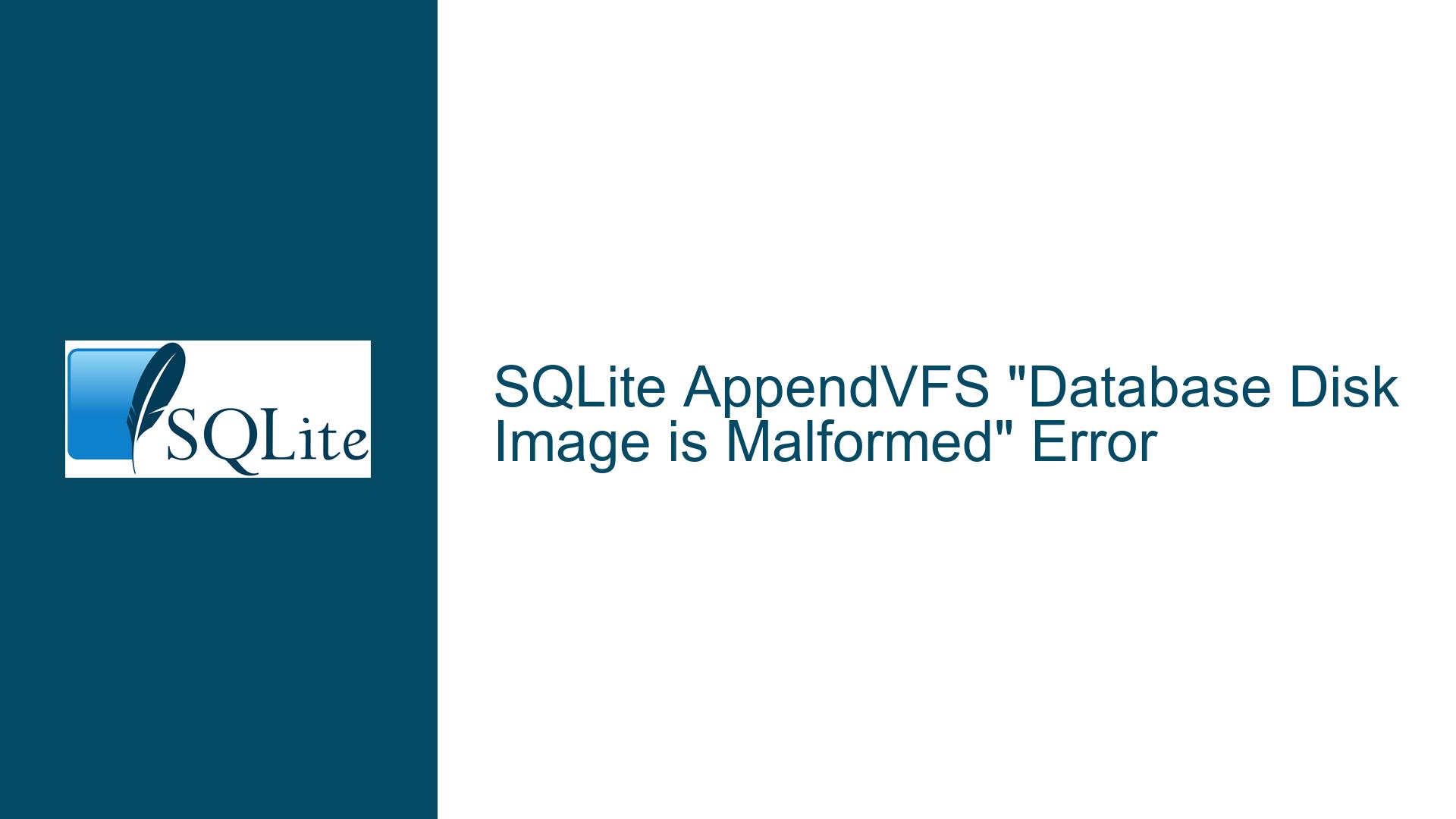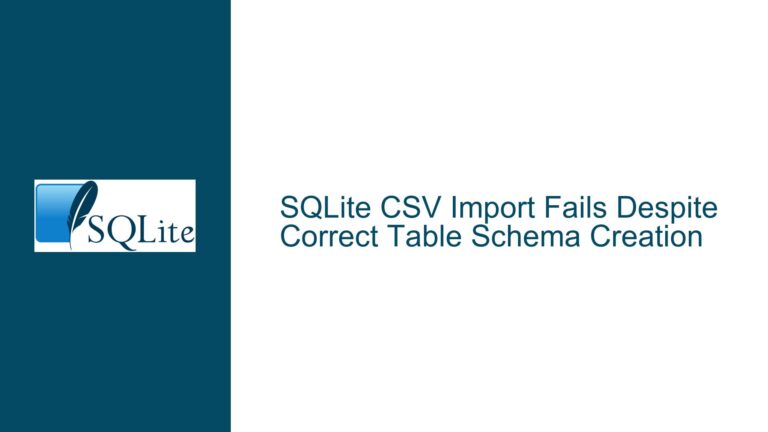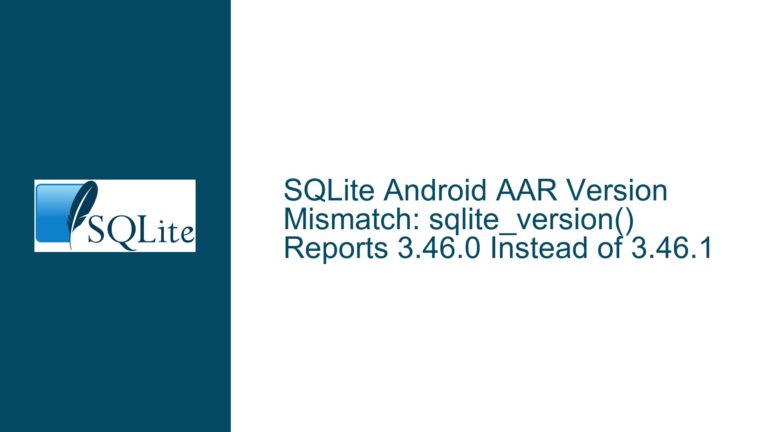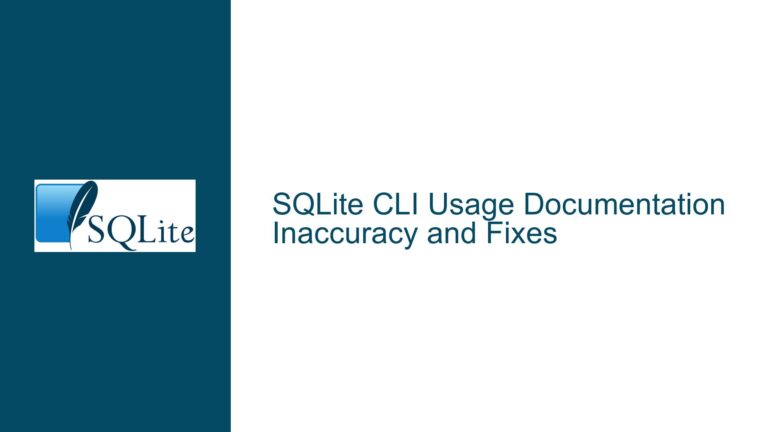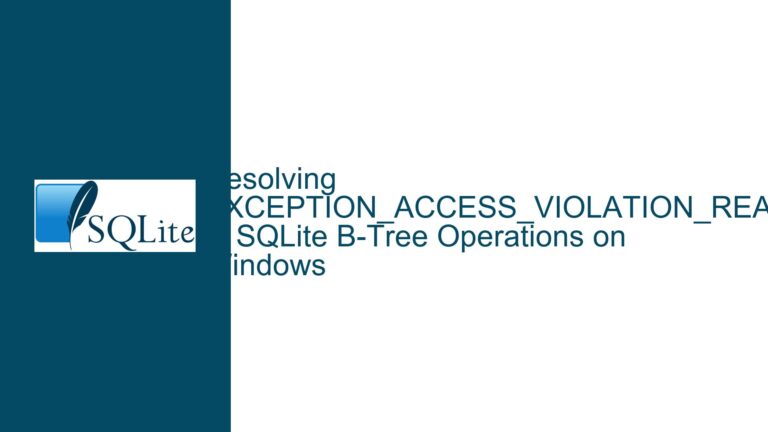SQLite AppendVFS “Database Disk Image is Malformed” Error
AppendVFS Database Corruption with UNIQUE BLOB Columns and Foreign Keys
The issue at hand involves the SQLite AppendVFS (Virtual File System) module, which allows databases to be appended to the end of an existing file, such as an executable. The specific problem arises when attempting to create tables with UNIQUE BLOB columns or foreign key constraints within an appended database. The database appears to be created successfully, but upon reopening, SQLite reports a "database disk image is malformed" error. This error indicates that the database file is corrupted or improperly structured, preventing SQLite from reading it.
The corruption occurs under specific conditions: when tables with UNIQUE BLOB columns are created, or when foreign key constraints are added. The database file itself, when inspected manually, appears to be correctly structured, and slicing off the appended portion reveals a valid SQLite database. This suggests that the issue lies in how AppendVFS handles the growing database file, particularly when certain schema elements are introduced.
The problem was traced to a bug in the AppendVFS implementation, specifically in how it manages file growth and memory-mapped I/O operations. The bug was introduced in scenarios where the database grows significantly due to the addition of complex schema elements, such as UNIQUE BLOB columns or foreign key constraints. The fix, which has been implemented in the appendvfs_fix branch of the SQLite source repository, addresses this issue by correcting the handling of file growth and memory-mapped I/O in AppendVFS.
Memory-Mapped I/O and File Growth Handling in AppendVFS
The root cause of the "database disk image is malformed" error lies in how AppendVFS manages memory-mapped I/O and file growth. SQLite uses memory-mapped I/O to improve performance by mapping portions of the database file directly into memory. This allows for faster read and write operations, as the database engine can access the data directly from memory rather than performing disk I/O.
However, when using AppendVFS, the database file is not a standalone file but is appended to another file, such as an executable. This introduces complexities in how SQLite handles memory-mapped I/O, particularly when the database grows in size. The bug in AppendVFS manifests when the database file grows beyond its initial size, especially when adding tables with UNIQUE BLOB columns or foreign key constraints. These schema elements require additional storage and indexing, which can cause the database file to grow significantly.
The issue is exacerbated by how AppendVFS handles the transition between the appended portion of the file and the original file. When the database grows, AppendVFS must ensure that the new data is correctly appended and that the memory-mapped I/O operations remain consistent. The bug caused inconsistencies in how the file growth was managed, leading to a malformed database image when the file was reopened.
The fix involves correcting the logic in AppendVFS that handles file growth and memory-mapped I/O. Specifically, the fix ensures that the file size is correctly updated and that memory-mapped I/O operations are properly synchronized with the underlying file. This prevents the database from becoming corrupted when it grows due to the addition of complex schema elements.
Implementing the AppendVFS Fix and Best Practices for Schema Design
To resolve the "database disk image is malformed" error, users must update their AppendVFS implementation to include the fix from the appendvfs_fix branch. This involves replacing the existing appendvfs.c file with the corrected version and rebuilding the SQLite amalgamation. Once the fix is applied, the issue should no longer occur, and users should be able to create tables with UNIQUE BLOB columns and foreign key constraints without encountering database corruption.
In addition to applying the fix, there are several best practices that users should follow when designing schemas for use with AppendVFS. These practices can help prevent similar issues and ensure that the database remains stable and performant:
Avoid Excessive Use of UNIQUE Constraints on Large Columns: UNIQUE constraints, particularly on large BLOB columns, can significantly increase the size of the database and the complexity of the indexing structures. This can lead to rapid file growth and increase the likelihood of encountering issues with AppendVFS. Where possible, consider using alternative approaches, such as application-level checks or hashing, to enforce uniqueness.
Minimize the Use of Foreign Key Constraints: Foreign key constraints add complexity to the database schema and can increase the size of the database file. While they are useful for maintaining referential integrity, they should be used judiciously, especially in scenarios where the database is appended to another file. Consider using application-level logic to enforce relationships where feasible.
Monitor Database File Growth: When using AppendVFS, it is important to monitor the size of the database file and ensure that it does not grow beyond the limits supported by the file system or the AppendVFS implementation. Rapid file growth can lead to performance issues and increase the risk of corruption. Consider implementing mechanisms to archive or split the database if it grows beyond a certain size.
Regularly Backup the Database: Given the potential for corruption when using AppendVFS, it is crucial to regularly back up the database. This ensures that data can be recovered in the event of corruption or other issues. Consider using SQLite’s built-in backup API or external tools to automate the backup process.
Test Schema Changes Thoroughly: Before deploying schema changes to a production environment, thoroughly test them in a development or staging environment. This includes testing the impact of schema changes on database file growth and performance. Use tools such as SQLite’s
.dumpcommand to inspect the database schema and ensure that it is correctly structured.
By following these best practices and applying the AppendVFS fix, users can avoid the "database disk image is malformed" error and ensure that their appended databases remain stable and performant. The fix addresses the underlying issue with file growth and memory-mapped I/O, while the best practices provide guidance on how to design schemas that are compatible with AppendVFS.
In conclusion, the "database disk image is malformed" error in AppendVFS is a result of a bug in how file growth and memory-mapped I/O are handled. The fix, available in the appendvfs_fix branch, resolves this issue by correcting the logic in AppendVFS. Users should apply the fix and follow best practices for schema design to prevent similar issues and ensure the stability of their appended databases.
